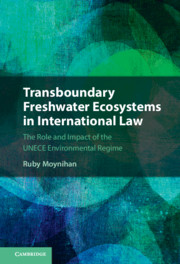 Transboundary Freshwater Ecosystems in International Law
Transboundary Freshwater Ecosystems in International Law Establishing the Basis for Coherent Interpretation and Institutional Interaction
Published online by Cambridge University Press: 01 October 2021
This chapter lays out a novel framework for conceptualising the water-relevant binding and non-binding instruments of the UNECE environmental conventions as one common normative regional environmental regime – an original contribution. In exploring the idea of a single regime, this chapter seeks to overcome a strictly positivist view of international law and understand the relevance of overlapping and/or non-uniform state membership of the UNECE legal instruments. It explores regionalism and regional approaches to international law and examines the relationship of the UNECE regime to international law and other international institutions. It sets out a framework for determining the UNECE regime’s relationship to general international law and other international water treaties – asking whether the regime lex specialis – a theme returned to throughout the remainder of the book. This chapter sets out a framework for exploring the making, implementation and enforcement of international law in the UNECE regime, which is employed throughout the research. This frame contributes to understanding around systemic integration, mutually supportive interpretation and cross-fertilisation in international environmental law and international law relevant to transboundary freshwater ecosystems.
To save this book to your Kindle, first ensure [email protected] is added to your Approved Personal Document E-mail List under your Personal Document Settings on the Manage Your Content and Devices page of your Amazon account. Then enter the ‘name’ part of your Kindle email address below. Find out more about saving to your Kindle.
Note you can select to save to either the @free.kindle.com or @kindle.com variations. ‘@free.kindle.com’ emails are free but can only be saved to your device when it is connected to wi-fi. ‘@kindle.com’ emails can be delivered even when you are not connected to wi-fi, but note that service fees apply.
Find out more about the Kindle Personal Document Service.
To save content items to your account, please confirm that you agree to abide by our usage policies. If this is the first time you use this feature, you will be asked to authorise Cambridge Core to connect with your account. Find out more about saving content to Dropbox.
To save content items to your account, please confirm that you agree to abide by our usage policies. If this is the first time you use this feature, you will be asked to authorise Cambridge Core to connect with your account. Find out more about saving content to Google Drive.